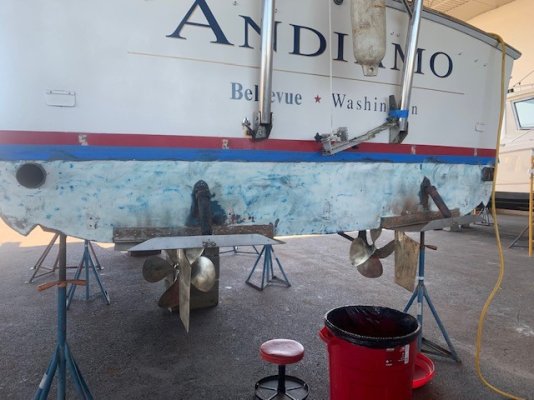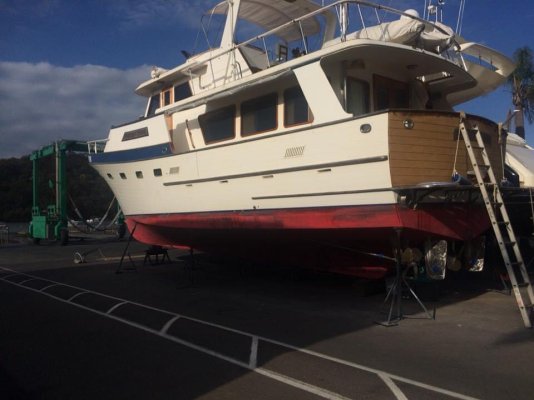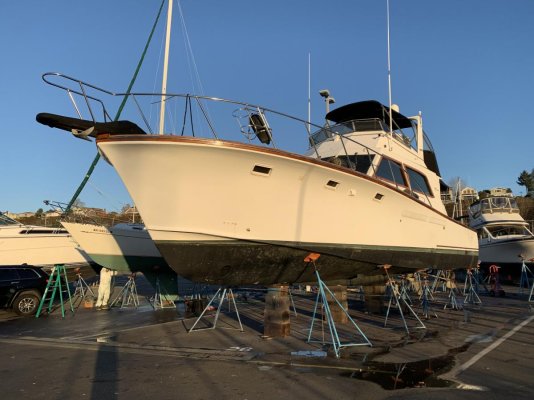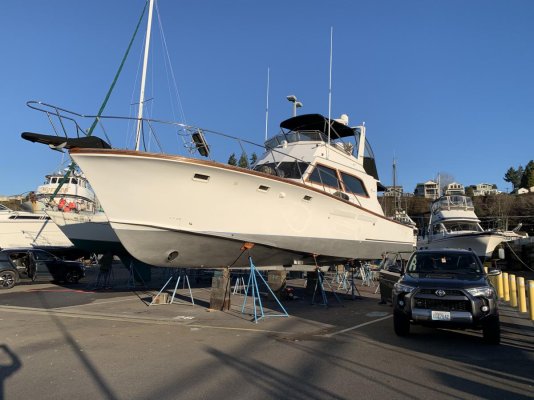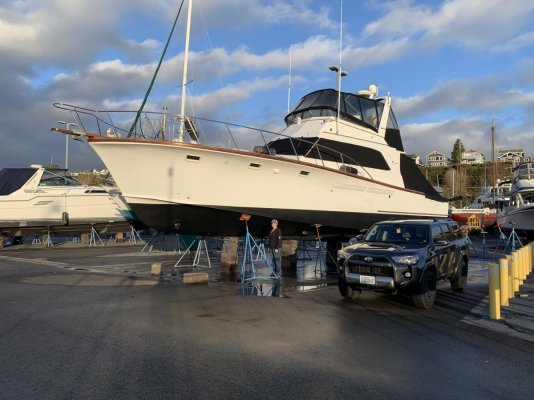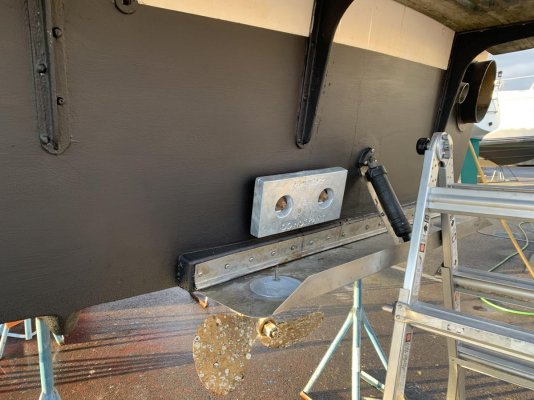You are using an out of date browser. It may not display this or other websites correctly.
You should upgrade or use an alternative browser.
You should upgrade or use an alternative browser.
Bottom paint, do it yourself or hire a pro?
- Thread starter RonR
- Start date
The friendliest place on the web for anyone who enjoys boating.
If you have answers, please help by responding to the unanswered posts.
If you have answers, please help by responding to the unanswered posts.
rslifkin
Guru
- Joined
- Aug 20, 2019
- Messages
- 7,584
- Location
- USA
- Vessel Name
- Hour Glass
- Vessel Make
- Chris Craft 381 Catalina
Are you sure your fuel consumption figures are correct. 110 NM at 75 gallons equals 1.46 NM/gallon doing 17 knots. Doing 12 knots you only got 1 NM/gallon. Is that correct?
BTW, the boat looks great!
It wouldn't shock me if he's nicely on plane at 17 kts and plowing at 12.
Comodave
Moderator Emeritus
- Joined
- Jul 2, 2015
- Messages
- 21,283
- Location
- Au Gres, MI
- Vessel Name
- Black Dog
- Vessel Make
- Formula 41PC
It could be and it also could be that the second trip was 70 NM, then the fuel consumption would look better. I just took it as it was 35 NM there and back total.
It could be and it also could be that the second trip was 70 NM, then the fuel consumption would look better. I just took it as it was 35 NM there and back total.
A quick look at the chart helps. There and back should be close to 70nm.
SalishSeaCHB
Veteran Member
What yard is that? We are next to Anacortes Marine Services and I think they are more than that.Ron,
Check the yard where you are planning to have the boat pulled. The yard where I have the work done charged me about $1,400 total including tax, taping, paint, cleaning the bottom, pulling and splashing the boat and lay days. During that time I was able to do some other projects such as changing zincs. Personally unless you are into it the difference in cost wasn't worth it for me to do it unless I was able to get the boat pulled and there was no charge for lay days.
RonR
Guru
Nice work Ron,
Here’s a random question for you (right of of left field). “Bottom paint”, do it yourself or hire a pro ?
If your able, do it yourself. If your not, hire it out.
I saved a fair chuck of cash doing it myself, but we are also in one of the most costly areas to hire work out.
RonR
Guru
Are you sure your fuel consumption figures are correct. 110 NM at 75 gallons equals 1.46 NM/gallon doing 17 knots. Doing 12 knots you only got 1 NM/gallon. Is that correct?
BTW, the boat looks great!
Thank you
Pervious info is wrong, I wrote it down, but did not bring the info home with me.
Two separate trips, first trip was 75 gallons of gas running around 17 kt for an average in a light chop. Total trip per the gps was 66.8 miles so what 1.12 gallons per mile?
Second trip was 63 gallons at 33 miles so 1.9 and yes we were doing going between 9-12kt and it plows at that speed, water was nice and flat! But we were just going for a nice slow ride.
I'm still playing with the trim tabs and trying to find the sweet spot of comfort/speed/economy. The boat's trim tabs never worked before, so this is all new to me. If I push the bow about 1/2 down it picks up speed on-step and the engine rpm goes up about 300-500rpm without touching anything. If I push it down all the way the boat slows down about 2kt and we spay up over the bow and its difficult to keep on track as it wonders p/s easy and takes a lot of effort to keep on track. If I am on-step and retract the tabs all the way the bow rides up about 4' and we lose speed for a given rpm.
Right now to reach on-step fast I push the trim tabs all the way down, bring the engines to 3000rpm and once it gets up out of the water I back the tabs down 1/2 way and bring the rpm's back down to 3000 as once its up the rpm's will go to 3300-3500.
I would also like to know hull speed and plan a trip at that speed to see what kind of range I can obtain. I'm thinking 7-8? 33'x about 12'
The boat will plain at 12.5 but it takes a lot of power to stay at that speed, if I bring it up to 13.5 I can back down on the gas.
Looks like 14-15kt will be the sweet spot, up ontop of the water but still under 3k rpm ( about 2750rpm). Boat weighs about 17,000 dry (according to the yard travel lift). We then added 200 gallons of gas and 35 gallons of water + a family of 4.
33' long and powered by two chev 350's that have about 425 hours each on the clock since new, has velvet drives that were also rebuilt at the same time as the engines were replaced. The stock props are on the shelf at home, I think the PO added larger props but the lock nuts cover the stamping. The only reason I say this is my max rpm is 4000, some other egg owners claim they can get to 4500 rpm but we end up doing about the same top speed.
The boat has dual fuel scans but I am unsure of how they work, most often they are reading 1.5-2 (2000-3000 rpm), but the total gallons never adds up to what I use. For instance it says for our two trips combined I used 35 gallons.
I think this reads gallons per hour, not gallons per mile. If I floor it and run it up to 4,000 rpm's the fuel scans will read 10 per engine. All I know is I don't trust them at this point and need to find more info on them. As at 3000 rpms and 17kt I think its close to 22 gallons per hour.
Last edited:
rslifkin
Guru
- Joined
- Aug 20, 2019
- Messages
- 7,584
- Location
- USA
- Vessel Name
- Hour Glass
- Vessel Make
- Chris Craft 381 Catalina
How big are your trim tabs? Going by the pictures, I'm going to guess they're either 24x9 or 30x9, so maybe a hair small, but nothing terrible. Going to wider span (covers more of the transom) tabs will let you run with them dropped to a smaller angle which gives less drag for a given amount of lift and will save you a little bit of fuel.
For my slightly stern heavy boat with big (48x12) tabs, I usually guesstimate (by time pressing buttons) the tabs to about where they'd need to be while on plane (about 1/3 of the way down or a hair less). Then throttle up and she climbs up on plane nice and smoothly. Once the boat stops accelerating, tweak the tabs to find best speed unless sea conditions require otherwise (trim down further in a head sea, up further in a following sea for ride comfort and handling at the expense of speed). I've never found a reason to drop the tabs all the way.
For an efficient slow speed cruise, you probably don't want to exceed 6.5 kts (estimating based on a 30-ish foot waterline length). With a 33.5 foot waterline length, I consider my slow cruise to be around 6.5 - 6.8 kts. I can push it to a little over 7 easily enough, but fuel burn and wake production definitely start to climb at that point.
Propped to turn 4000 at WOT, assuming you have Quadrajets or other vac secondary 4 barrels on your 350s, most efficient cruise will probably be somewhere in the 2900 - 3200 range. Re-propping to get WOT up to 4200 - 4400 may save you a little fuel up on plane, as it'll be easier to get to a speed where you're fully up on plane without getting into the secondaries.
Based on what you've said, it sounds like your fuel flow meters are either malfunctioning or just way out of calibration.
With small blocks, as a safe estimate based on the numbers you've given, I'd expect (for planning purposes) somewhere around 0.7 - 0.9 nmpg on plane, probably around 1.5 - 1.6 nmpg at low speed, maybe closer to 2 nmpg if you're lucky. With my fuel sucking big blocks in a somewhat bigger, heavier boat, I figure 0.5 - 0.6 nmpg on plane, about 1.2 at 6.5 - 7 kts.
For my slightly stern heavy boat with big (48x12) tabs, I usually guesstimate (by time pressing buttons) the tabs to about where they'd need to be while on plane (about 1/3 of the way down or a hair less). Then throttle up and she climbs up on plane nice and smoothly. Once the boat stops accelerating, tweak the tabs to find best speed unless sea conditions require otherwise (trim down further in a head sea, up further in a following sea for ride comfort and handling at the expense of speed). I've never found a reason to drop the tabs all the way.
For an efficient slow speed cruise, you probably don't want to exceed 6.5 kts (estimating based on a 30-ish foot waterline length). With a 33.5 foot waterline length, I consider my slow cruise to be around 6.5 - 6.8 kts. I can push it to a little over 7 easily enough, but fuel burn and wake production definitely start to climb at that point.
Propped to turn 4000 at WOT, assuming you have Quadrajets or other vac secondary 4 barrels on your 350s, most efficient cruise will probably be somewhere in the 2900 - 3200 range. Re-propping to get WOT up to 4200 - 4400 may save you a little fuel up on plane, as it'll be easier to get to a speed where you're fully up on plane without getting into the secondaries.
Based on what you've said, it sounds like your fuel flow meters are either malfunctioning or just way out of calibration.
With small blocks, as a safe estimate based on the numbers you've given, I'd expect (for planning purposes) somewhere around 0.7 - 0.9 nmpg on plane, probably around 1.5 - 1.6 nmpg at low speed, maybe closer to 2 nmpg if you're lucky. With my fuel sucking big blocks in a somewhat bigger, heavier boat, I figure 0.5 - 0.6 nmpg on plane, about 1.2 at 6.5 - 7 kts.
Last edited:
RonR
Guru
This is the first time in about 5 years this boat has gone this far. I started out with new fuel filters, but think it would be wise to swap them out now that I have ran a fair bit of fuel through them.
RonR
Guru
How big are your trim tabs? Going by the pictures, I'm going to guess they're either 24x9 or 30x9, so maybe a hair small, but nothing terrible. Going to wider span (covers more of the transom) tabs will let you run with them dropped to a smaller angle which gives less drag for a given amount of lift and will save you a little bit of fuel.
For my slightly stern heavy boat with big (48x12) tabs, I usually guesstimate (by time pressing buttons) the tabs to about where they'd need to be while on plane (about 1/3 of the way down or a hair less). Then throttle up and she climbs up on plane nice and smoothly. Once the boat stops accelerating, tweak the tabs to find best speed unless sea conditions require otherwise (trim down further in a head sea, up further in a following sea for ride comfort and handling at the expense of speed). I've never found a reason to drop the tabs all the way.
For an efficient slow speed cruise, you probably don't want to exceed 6.5 kts (estimating based on a 30-ish foot waterline length). With a 33.5 foot waterline length, I consider my slow cruise to be around 6.5 - 6.8 kts. I can push it to a little over 7 easily enough, but fuel burn and wake production definitely start to climb at that point.
Propped to turn 4000 at WOT, assuming you have Quadrajets or other vac secondary 4 barrels on your 350s, most efficient cruise will probably be somewhere in the 2900 - 3200 range. Re-propping to get WOT up to 4200 - 4400 may save you a little fuel up on plane, as it'll be easier to get to a speed where you're fully up on plane without getting into the secondaries.
Based on what you've said, it sounds like your fuel flow meters are either malfunctioning or just way out of calibration.
With small blocks, as a safe estimate based on the numbers you've given, I'd expect (for planning purposes) somewhere around 0.7 - 0.9 nmpg on plane, probably around 1.5 - 1.6 nmpg at low speed, maybe closer to 2 nmpg if you're lucky. With my fuel sucking big blocks in a somewhat bigger, heavier boat, I figure 0.5 - 0.6 nmpg on plane, about 1.2 at 6.5 - 7 kts.
Thank you for the info, I think they are about 3' each
They are holley v/s I think 650's but not positive on size.
Attachments
Begorrah
Veteran Member
Bottom Paint. I allways had LaConner Maritime pull my 32. They hauled it, pressuire washed it in the slings, blocked it, put down a tarp. then I scraped the bottom, repaired any little blisters and then painted it. Replaced zinks. Checked the props, shafts and rudders. I bought the paint from them. Cost for the above was about $900.00. Later on, I had them do the painting. Then the cost went up to about $1,250 or $1300.00. Did this about every 3 years. Good folks at LaConner Maritime. Allways get a firm quote before you have them do the work. They can give you a standard price list for doing this work.
ctjstr
Senior Member
- Joined
- Nov 24, 2017
- Messages
- 399
- Location
- United States
- Vessel Name
- "Convergence"
- Vessel Make
- Camano Troll
"Satisfaction" comes out of the water Tuesday. I've got the best of both worlds. I hate the prep work and don't mind the painting, I've hired someone to sand and prep the bottom, and Sara and I will paint it and change out the zincs. I'll pull the props and have them tuned and replace shaft seals. Also have a new thru hull transducer to install Just picked up the paint , transducer and seals at Fisheries today. Ouch! Even with my discount still up over 1700. Hope to only be out of the water a few days. Best laid plans.....
toni
toni
PamLeatch
Veteran Member
- Joined
- May 6, 2017
- Messages
- 31
- Location
- Australia
- Vessel Name
- Poseidon
- Vessel Make
- Ocean Alexander 50 MK1
"Satisfaction" comes out of the water Tuesday. I've got the best of both worlds. I hate the prep work and don't mind the painting, I've hired someone to sand and prep the bottom, and Sara and I will paint it and change out the zincs. I'll pull the props and have them tuned and replace shaft seals. Also have a new thru hull transducer to install Just picked up the paint , transducer and seals at Fisheries today. Ouch! Even with my discount still up over 1700. Hope to only be out of the water a few days. Best laid plans.....
toni
It’s an expensive hobby! We had hoped to go back in the water on day 5 and we were ready, but didn’t get some engine parts and the marina advised too gusty to tow us. So we spent the weekend painting, including the plimsoll line, outside the foredeck and some blue on the Portuguese bridge, and some other projects. Hopefully we go back in today (day 8).
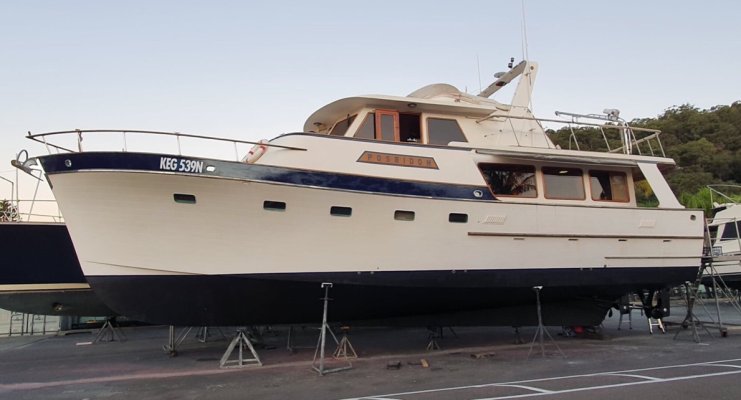
GregBrannon
Guru
Though this topic has been thoroughly covered, I'll add my experience from this year - my first time renewing the anti-fouling paint myself. My plan was to haul out one Friday and refloat next. I had to delay the haul out date twice for a month total due to stay-at-home orders and my work schedule. I used a paint estimating calculator to determine how much paint I'd need and ordered it to have before for the first haul out date. I think the calculator was on Interlux's site, but I'm not sure. As it turned out, the calculator was a bit shy of the actual requirement, estimating 4 gallons for 2 coats. I used 5 gallons to cover the bottom of my 48'L/16'B, twin-engine boat with 2 coats, slightly more than half for the first coat.
The boat was last painted in December of 2014. I hadn't hauled for 3 years but had the bottom cleaned by divers twice a year with the last diver 7 months ago remarking that the paint was due for renewal and the zincs were okay. On haul out, there was significant barnacle growth in patches. The yard did an excellent job removing growth with power washing and a long-handled flat scraper that looked like a sidewalk scraper. 75%-80% of the bottom had zero barnacle growth.
I had to recover from working nights for the first day on the hard, and the second day was Mother's Day. The mother of my children and captain didn't appreciate the scraper I got her to help with light barnacle scraping on Mother's Day, but we got a good assessment of what needed to be done and then made the day more about her. Thinking about returning to the water on the coming Friday, I decided that giving myself the next weekend made more sense and notified the yard of the change. Fridays at the yard are typically crazy, Mondays more relaxed, so the change was welcome and easily accommodated.
On the 3rd and 4th day on the hard, I prepped half days using an orbital sander/vacuum combo that I rented from the yard and 80-grit paper. My prep wasn't perfect. There are places that are hard to reach, like between the hull and stabilizers and in the shaft log wells. Props, shafts, and rudders were easy to clean up with a cordless drill and wire brush attachment. I replaced the shaft and rudder zincs which were all at ~20% remaining. Zincs were last changed by a diver exactly 2 years ago.
After prep, I added a coat each day for 2 days, starting other minor repairs while each coat completed the required 16-hour cure. The yard moved the stands early on the 7th day on the hard (Friday), and I was able to paint where the stands had been and complete the other in-progress repairs over the weekend.
I was very pleased and surprised that I was able to accomplish what I'd planned to do within the time I'd set aside for it. I had perfect weather for painting for the entire week, the ability to take 3 days off, and a cooperative/available yard, or I might not have been so lucky.
Here's a picture of the final product. I'm pleased with the results and would do it again, hopefully no sooner than 3 years from now.
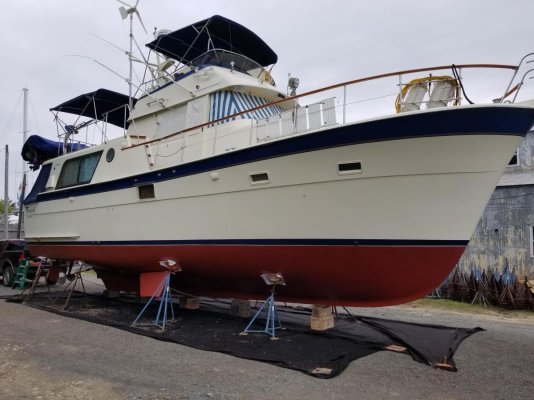
The boat was last painted in December of 2014. I hadn't hauled for 3 years but had the bottom cleaned by divers twice a year with the last diver 7 months ago remarking that the paint was due for renewal and the zincs were okay. On haul out, there was significant barnacle growth in patches. The yard did an excellent job removing growth with power washing and a long-handled flat scraper that looked like a sidewalk scraper. 75%-80% of the bottom had zero barnacle growth.
I had to recover from working nights for the first day on the hard, and the second day was Mother's Day. The mother of my children and captain didn't appreciate the scraper I got her to help with light barnacle scraping on Mother's Day, but we got a good assessment of what needed to be done and then made the day more about her. Thinking about returning to the water on the coming Friday, I decided that giving myself the next weekend made more sense and notified the yard of the change. Fridays at the yard are typically crazy, Mondays more relaxed, so the change was welcome and easily accommodated.
On the 3rd and 4th day on the hard, I prepped half days using an orbital sander/vacuum combo that I rented from the yard and 80-grit paper. My prep wasn't perfect. There are places that are hard to reach, like between the hull and stabilizers and in the shaft log wells. Props, shafts, and rudders were easy to clean up with a cordless drill and wire brush attachment. I replaced the shaft and rudder zincs which were all at ~20% remaining. Zincs were last changed by a diver exactly 2 years ago.
After prep, I added a coat each day for 2 days, starting other minor repairs while each coat completed the required 16-hour cure. The yard moved the stands early on the 7th day on the hard (Friday), and I was able to paint where the stands had been and complete the other in-progress repairs over the weekend.
I was very pleased and surprised that I was able to accomplish what I'd planned to do within the time I'd set aside for it. I had perfect weather for painting for the entire week, the ability to take 3 days off, and a cooperative/available yard, or I might not have been so lucky.
Here's a picture of the final product. I'm pleased with the results and would do it again, hopefully no sooner than 3 years from now.

Andiamo2018
Senior Member
Looks great! There is a lot you can do yourself if you have the inclination and time. Or if you are like me and just cheap lol
RonR
Guru
And another one is in the books.
Sanded with 80grit. Two coats of Interlux barrier paint. Three coats of Interlux bottom paint.
This time around I had a few extra hands show up and help paint.
Sanded with 80grit. Two coats of Interlux barrier paint. Three coats of Interlux bottom paint.
This time around I had a few extra hands show up and help paint.
Attachments
Now time to pull the props and send them out. I think they may need to be replaced..
Is that your new, bigger boat? What shows of the prop looks like a barnacle removal and maybe tuning required?
RonR
Guru
Is that your new, bigger boat? What shows of the prop looks like a barnacle removal and maybe tuning required?
The boat got caught up in a commercial crab pot in Westport on its last trip. Bend a rudder post, may have damaged one of the props. The props are 10 years old and show some pitting, nicks, and I would like to make sure there is no cracks. So I will pull them off and send them in to be checked.
psneeld
Guru
This is what I use...much less in price, similar results for WHERE I boat and HOW I boat....
Interlux
Fiberglass Bottomkote® NTFouling Control
Fiberglass Bottomkote NT (New Technology) is formulated with unique Dual Resin Technology, providing the benefits of both hard and ablative antifoulings. Combines durability, preventing premature wear-through, with slow polishing, ensuring consistent antifouling performance and a smooth finish.
Interlux
Fiberglass Bottomkote® NTFouling Control
Fiberglass Bottomkote NT (New Technology) is formulated with unique Dual Resin Technology, providing the benefits of both hard and ablative antifoulings. Combines durability, preventing premature wear-through, with slow polishing, ensuring consistent antifouling performance and a smooth finish.

